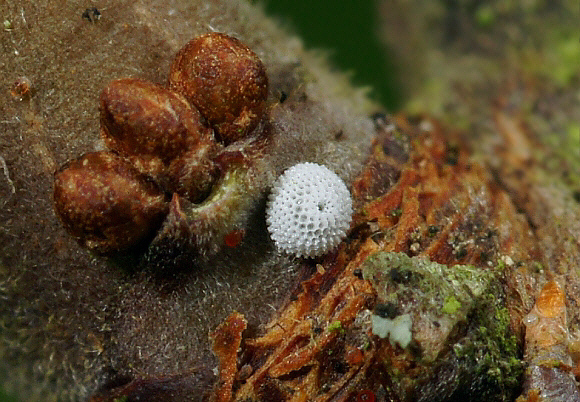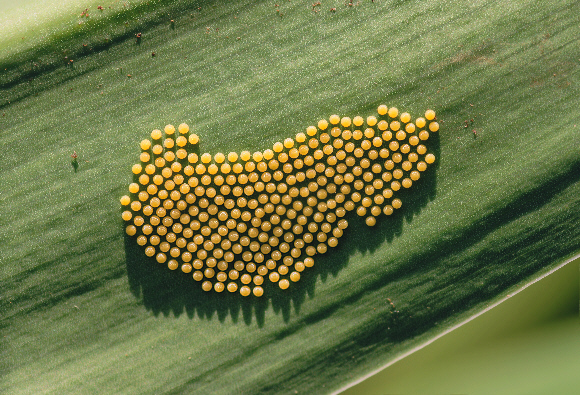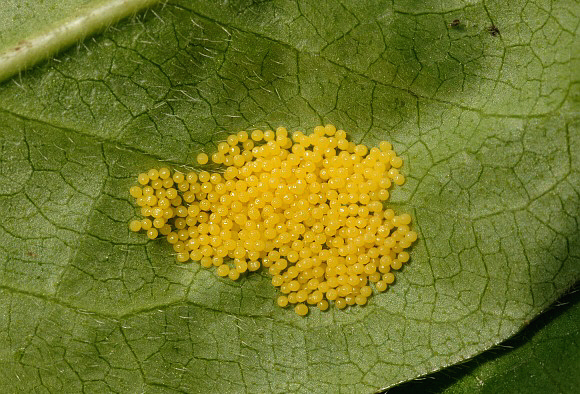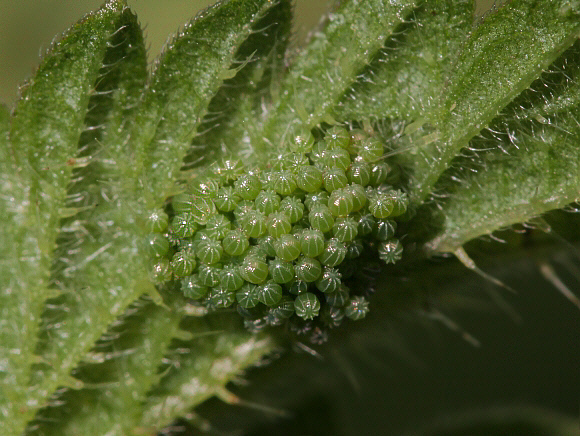Anatomy
The shape, size, colour and texture of butterfly eggs varies greatly from one species to another. Eggs of Satyrines and Heliconiines are typically domed or barrel-shaped, adorned with between 8-30 vertical ribs, between which can be seen dozens of lateral ridges. Most Hesperiidae, Papilionidae and Riodinidae produce smooth globular eggs. The eggs of Polyommatines have a finely reticulated surface, and are shaped like flattened do-nuts. Pierines produce tall skittle-shaped eggs, with fine vertical ribbing.
All butterfly eggs have a depression at the top, in the centre of which is a hole called the micropyle, through which sperm enters during fertilisation.
The egg shell also is peppered with thousands of microscopic pores called aeropyles. Microscopic examination of the eggs of Riodinidae, Lycaenidae and Limenitidinae species reveals them to be adorned with hundreds of minute hexagonal pits. Tiny hollow spines emerge at the intersections of each hexagon. These are also aeropyles, and act as breathing tubes for the developing larva.
 Thecla betulae egg details – Adrian Hoskins
Thecla betulae egg details – Adrian Hoskins
Fertilisation
In the case of Nymphalidae and most other butterflies the eggs are already formed within the body of females when they emerge. They grow in size over a period of 2 or 3 days as they mature within the female’s abdomen.
Egg-laying is triggered when they reach a certain size, at which time they pass from the ovariole to the egg chamber. They are fertilised just prior to egg-laying, the male’s sperm having been stored until this time within a receptacle in the female abdomen.
Oviposition
Butterflies lay their eggs either singly or in batches, on or near the foodplants that will be used by the caterpillars. Many species lay their eggs away from the foodplant, on dry grass stems, dead leaves or even on soil. This strategy prevents the eggs from being accidentally devoured by grazing animals. It also makes it more difficult for parasitoid wasps and flies to locate the eggs.
Some species, e.g. the Marbled White Melanargia galathea, drop their eggs randomly as they fly amongst tall grasses, but most species have very precise requirements. Pearl-bordered Fritillaries Clossiana euphrosyne for example lays their eggs singly on dead bracken or dry grass stems that are within a metre of their caterpillar’s foodplant, dog violet. The White-letter Hairstreak Satyrium w-album is even fussier, always laying it’s eggs on elm twigs, at the precise point where the new year’s growth and old growth meet.
Silver-washed Fritillaries Argynnis paphia lay their eggs in chinks on the bark of oak trees, but the larvae don’t eat oak – they begin by eating their own egg-shells, and then go into hibernation until the following spring, when they descend the tree trunks to feed on the leaves of nearby violets.
In the tropics eggs are often glued underneath the leaves of trees and bushes where they are protected from rain and from the desiccating effects of hot sunshine. In the Amazonian rainforests Heliconiine butterflies often lay their eggs on Passiflora tendrils, presumably to place them as far out of the reach of marauding ants as possible.
Orange tip caterpillars Anthocharis cardamines normally feed on cuckoo flower or garlic mustard leaves, but if they encounter another caterpillar they become cannibalistic. It would therefore be wasteful if more than one egg was laid on each plant, so the butterflies have evolved the ability to detect eggs that have already been laid by other females.
Studies have shown that many members of the subfamilies Pierinae, Heliconiinae, Danainae and Papilioninae have this ability, and avoid laying on plants carrying eggs laid by other members of their own genus or species.
Foodplant selection
The larvae of most species will only eat the leaves of one or two species of plant and will die if they find themselves on the wrong type of tree, bush or herb. Even oligophagous species – those that are able to feed on more than one type of plant – have a hierarchal order of foodplant preference, only accepting less nutritional species if they are unable to locate their preferred foodplant.
Butterflies therefore spend a great deal of time checking various leaves to ascertain whether they are of the correct species for egg-laying. Studies have shown that Heliconius, Battus, Colias and Perrhybris butterflies initially determine leaf choice by shape and size, but use taste and smell to confirm that the leaf is chemically “correct”.
It is common to see butterflies flitting from plant to plant, alighting momentarily on leaves, tasting the foliage using olfactory sensors on their feet. All female butterflies have spines on the underside of their forelegs. When they land on a leaf these spines puncture the surface, releasing aromas that are detected by the olfactory sensors.
It isn’t just enough to locate the correct species of plant. The eggs usually have to be laid on tender young leaves or buds, as the older leaves often contain toxins that can kill them. They also have to be laid on plants that are growing in very precise conditions – just the right degree of shade, just the right conditions of temperature and humidity, and at a height on the plants where they will not get eaten by browsing herbivores.
Eggs are often laid on the tips of buds, usually quite high up on the tree or bush. This way they are less likely to be found by ants. Female butterflies often spend long periods probing about with the tips of their abdomens, being extremely careful about the positioning of each individual egg.
In Peru Perrhybris pyrrha females habitually alight on almost any available leaf except ferns when searching for the Capparis leaves on which they eventually oviposit. A female will reject several Capparis trees before selecting a particular one. Having found a tree that suits her she will then spend up to 30 minutes comparing dozens of leaves. She will settle on a leaf-tip, run up towards the base of the leaf as if measuring it, and then move on to another leaf.
Eventually she narrows her choice down to just two adjacent leaves and then spends several minutes skipping back and forth between them before finally deciding which leaf to oviposit on. If she is disturbed part way through the oviposition process she will flee up into the canopy, but will return a few minutes later, relocate the leaf and complete laying the egg batch.
The factors that induce a female to lay on a particular specimen of tree or bush, or on a particular leaf, are often a mystery to human observers. Gonepteryx rhamni always lays its eggs singly but I have counted up to 19 on a single leaf, and up to 100 on a tiny bush. These may have been laid by a single returning female or by several females in succession.
These figures pale into insignificance however when learning about observations of various Capparis feeding species – In Kenya in 1926 Somersen estimated that a single 1 metre high bush of Capparis held about 57,000 eggs and young larvae of Belenois aurota.
In Sydney, Australia during a mass migration of Caper Whites Anaphaeis java, Waterhouse estimated that about 250,000 eggs were laid on a single 5 metre high Caper tree!
Laying in batches
Butterflies usually lay the bulk of their eggs within the first few days of their lives. Older females lay smaller eggs, and the resulting caterpillars take longer to mature, making them more prone to predation and parasitism. This is probably part of the reason why Perrhybris and numerous other species avoid delay, and have evolved to lay all of their eggs in a single batch immediately after copulation. This strategy also ensures that as many eggs as possible are laid before the butterfly falls prey to a bird, reptile, wasp or spider.

egg batch under leaf, species unknown, Peru – Adrian Hoskins
Some species lay their egg batches in neat clusters like that shown above, while others including Aporia, Euphydryas, Chlosyne and Aglais produce untidy heaps in which the eggs are up to 3 layers deep. I have also seen cases where Euphydryas aurinia females have laid their eggs on top of an egg batch produced by another female of the same species.
Laying in batches improves the survival prospects for individual caterpillars. Wasps preferentially parasitize eggs at the edges of batches because they cannot easily reach those at the centre with their ovipositors. It seems that a few individual eggs around the edge of the batch are sacrificed to ensure that the bulk of them at the centre of the batch are left alone. Eggs at the centre are also less likely to be eaten by predatory insects, and are much better protected against desiccation.
As might be expected there are also negative factors involved when a butterfly “puts all it’s eggs in one basket” – an entire egg batch could be deliberately eaten by a bird, snail, reptile or amphibian; or accidentally consumed by a grazing animal. To reduce the likelihood of this happening butterflies choose their egg-laying sites with great care.
Several Nymphalidae genera including Hamadryas, Polygonia and Araschnia lay their eggs in long vertical strands, dangling from the underside of leaves. Hamadryas amphinome sometimes lays in strands of up to 15 eggs long. It is not known what advantage the butterflies gain by adopting this strategy – perhaps the eggs at the end of the string are less susceptible to leaf mould?

egg batch of Marsh Fritillary Euphydryas aurinia, Wiltshire, England – Adrian Hoskins

egg batch of Small Tortoiseshell Aglais urticae, Hampshire, England – Adrian Hoskins
Maturation
With many species of butterfly the eggs need to mature within the female for between 3-6 days before egg laying commences. Once this period has elapsed, oviposition activity is controlled at least partially by the butterfly’s inbuilt biological or “circadian” clock. Hence she will only lay her eggs at a particular time of day, during which her activities adhere to a “rest-feed-fly-oviposit” sequence.
This is triggered and modified by environmental cues such as temperature and light levels. The “oviposit” part of the sequence, often referred to simply as an egg-laying run, typically lasts for about 5 minutes, but can be shortened if cloud obscures the sun and lowers temperatures.
Incubation
The incubation period varies greatly from species to species. Eggs of tropical butterflies usually hatch within a week, but in temperate areas 10-14 days is more typical.
There are however many species, such as Purple Hairstreak Quercusia quercus, Chalkhill Blue Lysandra coridon and High Brown Fritillary Argynnis adippe, in which the eggs hibernate over winter, and in these cases the incubation period can last for several months.
Egg parasites
The eggs of butterflies and moths are valuable sources of protein. In addition to the threats from birds, snails, reptiles, amphibians and grazing mammals already mentioned, they are prone to parasitisation by microscopic wasps and flies.
It may seem surprising that something as small as a butterfly egg has its own parasitoids, but these cause high losses. The main parasitoids are wasps in the families Scelionidae and Trichogrammidae – as many as 60 of these can emerge from a single butterfly egg !
